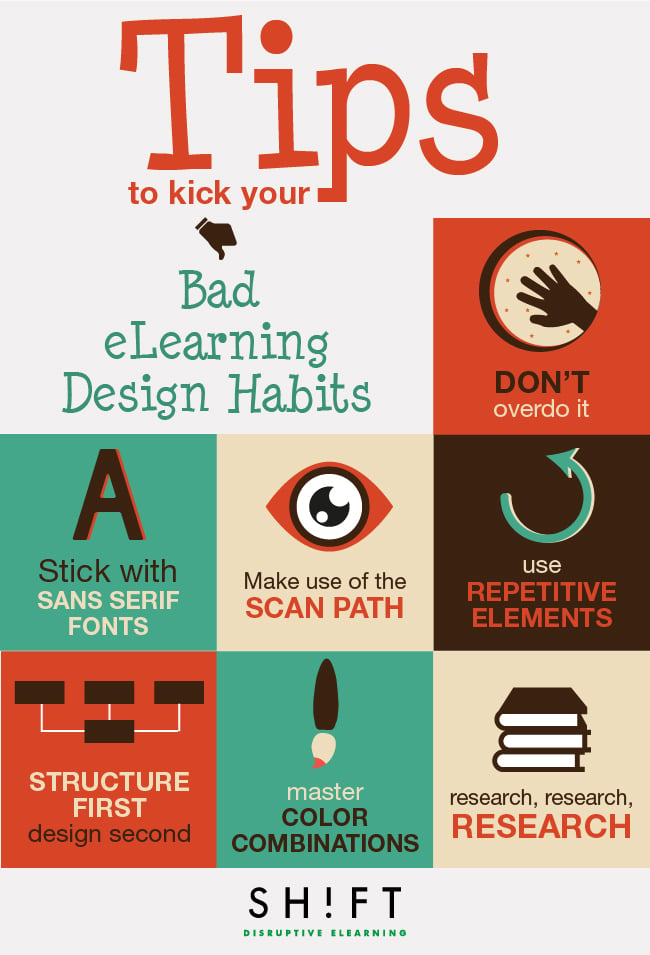Every eLearning project is different, and comes with a different set of demands. However, when it comes to slide design, there are some best practices that fit all or nearly all situations. Following these basic tips ensures a clear and effective lesson, while still leaving room to customize and add your own personal touch.
1. Don't overdo it.
According to Cognitive Load Theory, the brain can only process so much new data at a time. Too much, and learners' minds are too busy sorting through the new information to actually absorb any of it. Provide multiple avenues of learning, but don't force learners to parallel process. Make sure all your graphics are adding new and critical information, and don't read off the slides.
Mind you, too little information is just as bad as too much, sending learners' minds wandering so they lose track of what you're trying to convey. Look for a happy medium.
2. Stick with Sans Serif Fonts
Some sans serif fonts, such as Verdana, were designed specifically to be read on a computer screen. Even those that weren't are simpler, with less visual "noise" to deal with.
For best results:
- Use Arial 12-point font - or larger; don't forget that older readers may find fonts 14-point and over an easier read.
- If you need to go smaller, Verdana 10-point is about your minimum.
- If you feel the need for a more formal look, try Georgia instead of going to a serif font.
Read more typography tips for eLearning here.
3. Make Use of the Scan Path
Web usability experts use the term "scan path" to refer to the natural tracking of web readers' eyes as they view a page. For best results, you want your slide format to work with, not against, the scan path. Here's a basic guide:
- The eyes' natural path on screen is in a F shape, starting at the top/left and ending in the bottom right.
- Headlines and sub-headlines serve as signposts and should be usable as such.
- Bullet points and numbered lists keep focus on important points.
- Shorter paragraphs are easier to read.
- White space gives the eyes a rest, while colored text draws attention.
4. Use Repetitive Elements
Don't repeat everything, of course, but a consistent framing and design scheme helps fit the course into a cohesive whole. Having unity is vital so that learners can quickly and easily find patterns, make sense of information, and find connections between concepts. Looking back up the list, it also reduces cognitive load by cutting down on the amount of new information.
It's critical to make your layout consistent: make sure your headings are always in the same place on the page, and use the same typeface and font size throughout. This is easily achieved in eLearning design by creating a style guide.
5. Structure First, Design Second
Have a detailed plan before opening your authoring tool so you stay on-track. Try storyboarding, so that you start the design process with a clear understanding of how each slides fits into the whole.
Above all, keep track of your ultimate goal. Check back every slide: does this support the overall goal? If not, get rid of it.
6. Master Color Combinations
Developers who are new to designing eLearning courses often choose colors based around their own personal tastes and preferences. Sometimes this works well, particularly when the designer has a good eye for what makes attractive combinations and what would be the right color scheme for the course. Those who are not so naturally talented would do best to refer to the basics of color theory.
Color theory instruction can be helpful, but it can also be too, well, theoretical to solve the problems facing eLearning designers right away. These are some websites with a sample palettes for you to use, bookmark and take as inspiration: Betterment, Codrops, and Spyre Studios.
- Here are 50 different color palettes you can use for your inspiration.
- Here are 25 examples of perfect color combinations for web.
- These are the five color combinations you should never use in web design.
6. Research, Research, Research
These are only basic guidelines; in order to make the best possible use of your slide space, here are some books to help you learn more:
- Slidology by Nancy Duarte;
- Presentation Zen by Garr Reynolds;
- Resonate by Nancy Duarte;
- Brain Rules by John Medina.
Do you have other tips? Share them with us!









